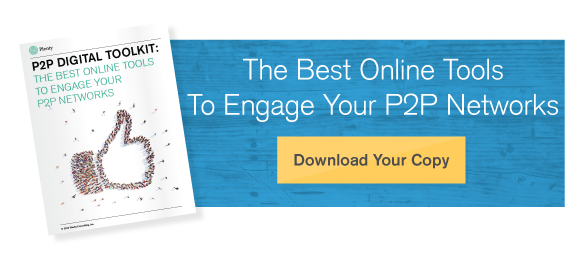On The Market For A New Fundraising Campaign? 3 Ways To Get Moving
Let’s play a quick word association game. I’ll say a word, and you say (or write, or think quietly to yourself at your desk) what that word brings to mind. Ready?
Moving.
What did you think of? Chances are, terms like: “stressful,” “expensive,” or “inconvenient” came to mind. Whether based upon a bad experience moving a grand piano through a crooked hallway, or just a gut response to the idea itself, I’d wager that most responses fell on the negative side of the adjective spectrum. It’s no surprise that we humans are hard wired to either dread change or avoid it entirely, especially when predicated upon doing a lot of (literal or figurative) heavy lifting. And unfortunately, this often precludes us from making necessary changes in our personal and professional lives.
I almost fell into this trap recently when contemplating a move from my expensive neighborhood in Chicago to a more hip, affordable, and conveniently located spot. And despite my certainty that the move was right for me, I spent an entire month thinking up reasons why my old apartment wasn’t so bad – all of which were thinly veiled excuses to avoid the chaos of the move. On paper, my past situation wasn’t working financially, socially, or emotionally – and yet I almost didn’t sign a new lease for fear of a transition period that would quickly be eclipsed by the length of my tenancy in a new, better place.
During this moving process, I attended the Nonprofit Technology Network’s Campaign Planning and Management Lab in Chicago, and heard my internal dialogue echoed throughout the workshop. What began as an interactive activity of creating narrative arcs for impactful storytelling meandered into a deeper conversation about the effectiveness of engagement channels themselves, and whether or not the represented organizations were providing the right opportunities for their constituents to hear, react to, and act upon their stories. Many of those organizations still relied upon annual or semi-annual galas, silent auctions, and awards luncheons to bring in big bucks – but most acknowledged that their calls to action were met with a collective groan.
I was thrilled that the dialogue addressed the critical question of “Are we designing for what our constituents really want?”, but also knew that everyone in attendance could already answer that question for themselves – and that answer was a resounding “No! And,…” The rest of that answer included creative and interactive ideas for new campaigns that had yet to move from ideation to conception. It became apparent to me that, while my colleagues were well equipped to leave the past behind for experiential, constituent-focused offerings, something was holding them back. And that something was a plan for navigating and managing the change from old to new.
If you’re saddled with a great idea for a new fundraising campaign or program, and wondering how you’re going to haul it from ground zero up to the next level of fundraising success, don’t stress! Let us help move you forward with the three first steps you should take in order to leave the past behind and start fresh.
Understand Why “The Way We’ve Always Done It” Isn’t WorkingWhether you represent a smaller organization and you’re tasked with planning the 46th annual gala, or you’re part of a larger team that pours massive resources into direct mail offerings, it’s important to understand and articulate why business as usual is no longer an option.
First, take a look at the data. If all you’ve got is year-over-year revenue and number of donors, then that’s a fine start to illustrate trends. If you can dig deeper into who is powering your program, where they’re coming from, and how long they’re supporting you, even better. Beyond year-over-year revenue, be on the lookout for patterns that indicate a lack of revenue diversity (is all of your money coming from one wealthy constituent?), support concentrated only in older age groups, a low number of repeat participation, or a lack of new faces year-over-year.
Then, consider the trends in the social good space that are now requiring innovative, creative, and authentic campaigns from nonprofit organizations. We’ve said it before and we’ll say it again – your constituents’ expectations are rapidly changing, and they’re being defined not by organizations that look like yours, but by for-profit initiatives like Apple's Project Red Campaign. Does your current campaign inspire action, or yawns?
Finally, take a look at your goals and consider where you’ll be in a year, two years, five years. Will you be scrambling for dollars from other sources to close a gap left by the current holding? How deep will that gap be? Answers to these questions should close your case for a new path forward.
Validate Your Target AudienceWhether your new campaign is targeted to a burgeoning group of new young supporters or your loyal core, it’s important to validate who your target audience is. An effective target audience packs enough punch to power your fundraising program, but is small enough to cater to your resources. Start by exploring which groups of your constituents have powered growth historically. If you can’t get farther than “women ages 35-54” from the numbers, then narrow down the base by asking them some questions. For example; What do they do? How did they find out about your organization? What other activities are they involved in? Most importantly, find out why they care about your cause.
You may find that women who are new empty nesters with dogs are your target audience.
It’s important to note that you may surface a target audience that is different than your traditional donor base. Whatever the swath is, your newly defined target will serve as your guide and sounding board as you develop and consider new campaign ideas.
Cater To Your Target’s PreferencesArmed with your newly defined target audience, you may feel empowered with enough information to design your new campaign. Not so fast – understanding your target audience isn’t the same as understanding your target audience’s preferences. Think of this part of campaign development like writing a book that will be distributed to a large retailer. Your target audience definition tells you what section your book will be in – Young Adult, North American Travel, Dogs, etc. Your target audience’s preferences tell you what to write about so that your book gets purchased.
The easiest way to go about this? Ask! Deploy a survey, post questions on your Facebook page, or pick up the phone and call your constituents. Ask them if they’re happy with their opportunities for engagement, what they’d like to see you do in the future, and what they think about a few new ideas. Further, find out what campaigns (even if they aren’t yours!) have resonated with them either inside or outside of the nonprofit space. Don’t miss this opportunity for a collective brainstorming session and listening interview – the feedback you’ll get is invaluable.
So, you’ve surfaced a narrative about why change is needed. You’ve also surfaced a target audience that’s most likely to impact revenue growth through a new campaign. Finally, you’ve asked that audience what factors are most important to them – and most likely to inspire them into action. These building blocks form a solid case for support that your new idea should be given its day.
When the next bright idea pops into your mind, or you utter another sigh as you contemplate planning the same old campaign, don’t fear the move. Lean on these resources and steps, put on your working shoes, and let us help you navigate the stairs – the view is a whole lot nicer from a second floor window.
As you build out a plan for how your campaign will actually take shape given your resources and time, consider the eight most cost-effective digital tools for building peer-enabled campaigns. Most are free, all are peer-enabled, and all will enable your message to be heard over the increasingly high volume of worthy causes and actions available to your constituents. Explore these eight tools in our latest e-book "The P2P Digital Toolkit." Download your free copy today!
Share this
You May Also Like
These Related Stories

Seven Things Keeping You From Peer-to-Peer Fundraising Success

The Best Decision You'll Make All Year




Comments (1)